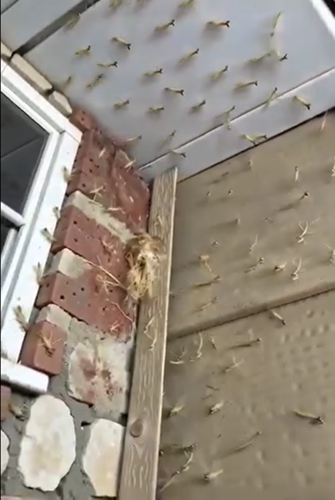One quiet morning, as I stepped outside, I was greeted by a stunning surprise: dozens of tiny praying mantises crawling across my doorstep. No larger than the tip of my pinky finger, these delicate hatchlings had just emerged from an egg case—known as an ootheca—hidden near my front door.
The female mantis carefully constructs this foam-like case and attaches it to sturdy surfaces like branches, walls, or fences. Inside, up to a hundred eggs develop safely, protected from the cold and predators, until they hatch in the warmth of spring.
Praying mantises are instantly recognizable by their “praying” posture, their forelegs folded gracefully in front of them. But don’t let their serene pose fool you—they’re formidable predators. With lightning-fast reflexes and powerful, spiny front legs, mantises feed on a variety of pests like flies, mosquitoes, aphids, and caterpillars. Their large, independently moving eyes offer almost 360-degree vision, making them incredibly aware of their surroundings.
Watching the hatchlings scatter and explore was nothing short of magical. Some clung to the brick wall, others vanished into nearby shrubs, blending almost invisibly with the greenery. It felt like witnessing the very beginning of a hundred tiny lives—a quiet but powerful reminder of nature’s ever-renewing rhythm.
If you’re lucky enough to spot mantis hatchlings near your home, observe them gently and avoid disturbing their space. They’re fragile at this stage and benefit from nearby plants for shelter and food. Refraining from using pesticides ensures their safe development. Over the coming weeks, these miniature hunters will shed their skins several times before reaching adulthood.
Beyond their role in pest control, praying mantises carry deep symbolic meaning across cultures. In Chinese tradition, they represent patience and mindfulness. In parts of Africa, they’re considered omens of good luck and wisdom. Native American stories often portray them as quiet teachers of awareness and stillness.
That morning encounter was more than just an unusual sight—it was a reminder that nature’s quiet miracles unfold around us every day, often when we least expect them. All we have to do is slow down and notice.




